Licensed Deck Contractor near me
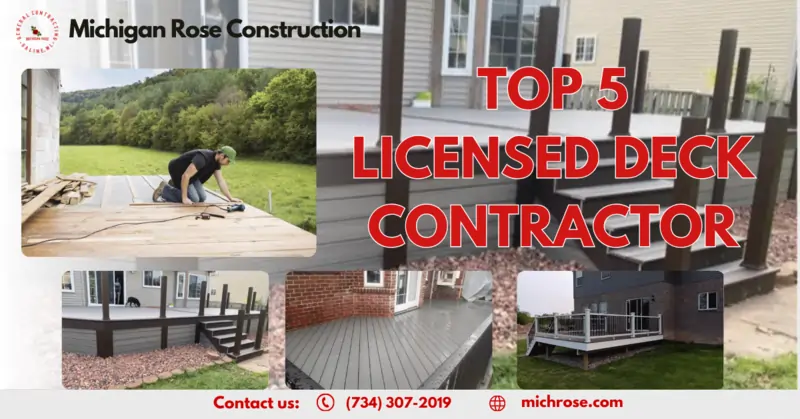
Licensed Deck Contractors near me: Why You Should Hire a Contractor for Your Deck Licensed Deck Contractors near me: Backyard decks are incredibly popular in Michigan. In fact, over 65% of homes in the state have some type of deck for outdoor entertaining and relaxation. With spring and summer right around the corner, you may be thinking about building a new deck or sprucing up your existing one. Hiring a professional, licensed deck installation contractor is highly recommended for this type of home project. This article provides a list of the top 5 licensed deck contractors in Michigan. We’ll also cover important factors like checking credentials, cost and budget, design trends, and maintenance. Our goal is to equip you with the knowledge to find the best deck pro for your job and end up with results you’ll love. Benefits of Hiring a Licensed Deck Contractor Hiring a licensed deck contractor near me provides several important benefits compared to hiring an unlicensed handyman or doing it yourself. The biggest benefit is avoiding injuries and accidents with proper construction methods and materials. Licensed contractors have the expertise to build a structurally sound deck that meets local building codes. They use high-quality decking materials and hardware designed for longevity. A deck that is not properly supported or built with substandard wood can be dangerous and collapse under weight. Licensed contractors have passed exams and met experience requirements for their state. This ensures they have the right knowledge and skills to safely build a quality deck. They keep up with current building codes and construction best practices. Licensed deck builders also carry liability insurance and worker’s compensation for employees. This protects homeowners financially if someone were to get injured on the job. With a licensed contractor, you gain peace of mind knowing your new deck is built safely by qualified professionals. How to Check a Contractor’s License When hiring a deck contractor, it’s important to verify their license status. Here are some tips: Taking these steps helps ensure you hire a deck pro who is properly licensed and in good standing before they start work on your home. This helps avoid potential issues down the road. Questions to Ask a Deck Contractor When interviewing deck contractors, you’ll want to ask the right questions to determine if they are the right fit for your project. Here are some key questions to ask: How long have you been in business? An established company with years of experience is ideal. This demonstrates they have a proven track record and the skills to properly build and finish a deck. How many projects like mine have you completed? Look for a contractor who has extensive experience building decks similar to yours. Custom decks with detailed finishes require specialized expertise. What materials and brands do you use? High-quality decking materials like pressure-treated lumber, composite, or tropical hardwoods will withstand the elements. Make sure they work with reputable brands and offer warranties on materials. Do you handle the permit process? Many municipalities require permits for deck building. A knowledgeable contractor will handle the permitting process for you. This ensures the deck meets all code requirements. What is the timeline and process? Professional contractors will outline the full project timeline, from planning and permits to construction and cleanup. Expect regular progress updates and communication throughout the process. Asking these key questions helps you evaluate expertise, experience, workmanship and customer service. A contractor who can confidently answer these questions is likely a good choice for your deck project. Top 5 Licensed Deck Contractors in Michigan Michigan Rose Construction Michigan Rose Construction is a licensed deck contractor located in Detroit, Michigan. They have been building beautiful decks for over a year and are known for their craftsmanship and attention to detail. Michigan Rose Construction offers all aspects of deck building including design, permitting, demolition of old decks, framing, decking material installation, railings, stairs, lighting, and more. They work with a variety of materials including wood, composite decking, aluminum, and PVC. “We couldn’t be happier with the new deck that Michigan Rose Construction built for us. The whole team was professional, skilled, and a pleasure to work with from start to finish,” said a recent customer. Deck Masters Located in Grand Rapids, Deck Masters is a licensed deck construction company that has been building decks for over 20 years. They specialize in custom wood and composite decks and also offer 3D design renderings. Deck Masters handles everything from permits to demolition to maintenance. Great Lakes Decks Great Lakes Decks, located in Traverse City, is known for their artistry and carpentry skills. They customize every deck to match the homeowner’s vision and lifestyle. Their crew has over 50 years of combined experience constructing stunning decks throughout northern Michigan. Arrow Decks Serving Lansing and mid-Michigan, Arrow Decks is a licensed and insured deck construction company. They offer expertise in low maintenance and environmentally friendly decking products. Arrow Decks provides free consultations and estimates. Wolverine Decks Wolverine Decks has been a licensed deck builder in the Ann Arbor area for over 10 years. They handle small residential decks up to large commercial deck projects. Wolverine Decks is recognized for sustainable and long-lasting deck construction. Cost and Budget The cost of building a new deck can vary significantly based on the materials used, size, and complexity of design. However, most sources estimate the average cost to be between $15-40 per square foot for materials and labor. This means a basic 12×12 foot deck would cost $2,160-$5,760. Some of the main factors that affect deck building costs include: To get the best value, it’s recommended to get quotes from 3-4 licensed deck contractors before deciding on one. Quotes allow you to compare costs for similar projects, taking into account materials, size, design, and labor. Be sure to get itemized quotes breaking down material and labor expenses. This gives you a good baseline for budgeting and choosing the right deck builder for your project and budget. Keep in mind that cheaper isn’t always better when
Paver Walkway – Tips for a Perfect Pathway
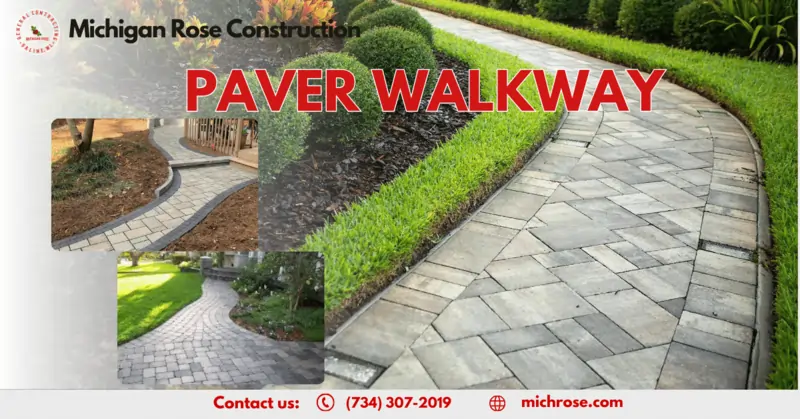
Introduction Does your Michigan home lack that certain curb appeal? Cracked concrete paths leaving an eyesore first impression? Here in the Mitten State, the freeze-thaw cycle can wreak havoc on traditional walkways. But fear not, homeowners! Paver walkways offer a stylish and durable solution built to withstand Michigan’s toughest weather conditions. In this blog, we’ll delve into the many reasons why paver walkways are the perfect choice for your Michigan home. We’ll explore the benefits of pavers over traditional materials, the design possibilities they offer, and how they can add value and functionality to your property. So buckle up and get ready to transform your entryway from mundane to magnificent! Paver Walkways Paver walkways are paths made from individual pavers or blocks rather than poured concrete. Pavers are available in a variety of shapes, styles, colors, textures and materials to fit any landscape design. Compared to poured concrete, paver walkways offer many benefits: The most popular paver materials are: The shape and pattern possibilities are endless with pavers. The most common paver styles are square, rectangular, hexagonal, circular and tumbled. Planning Your Paver Walkway Installing a paver walkway requires careful planning and preparation to ensure it lasts for years to come. Here are some key factors to consider: Drainage and Slope Proper drainage is critical for a long-lasting paver walkway. Water should drain away from the house and off the sides of the path. A slight slope of 1/8 to 1/4 inch per foot is ideal. Use a level and stakes to mark the slope. Avoid overly steep slopes which can lead to erosion. Width Consider the walkway’s purpose when planning the width. A main path to the front door should be 36-48 inches wide. Narrower 18-24 inch paths work well for garden walkways. Wider walkways allow two people to walk comfortably side-by-side. Base Preparation Proper base preparation is crucial. Excavate at least 6 inches deep and add a 4-inch gravel base. Compact the gravel and level it before installing 1-2 inches of sand. This provides drainage and a solid foundation for the pavers. Careful planning for drainage, width, and base preparation makes for a long-lasting, functional paver walkway you’ll enjoy for years. Prepare the base properly before installing pavers. Paver Walkway Patterns Paver walkway patterns add visual interest and style to your outdoor space. Choosing the right pattern is an important design decision that impacts the overall look, cost, and installation complexity of your walkway. Here are some of the most popular paver patterns to consider: Herringbone The herringbone pattern features rectangular pavers placed in an interlocking arrangement that resembles a herringbone pattern. Pavers are laid at 45 or 90 degree angles to each other in alternating rows. Pros: Cons: Basketweave Basketweave patterns feature rectangular pavers woven in an over-under pattern resembling a basket weave fabric. Each paver is laid perpendicular to the adjacent pavers. Pros: Cons: Stacked Bond Stacked bond patterns feature pavers stacked in a grid or running bond pattern with continuous straight joints. Rectangular pavers are laid in straight rows off-set by half a paver length each row. Pros: Cons: The pattern you select can increase material and labor costs, especially for more intricate layouts like herringbone that require cutting pavers and precision installation. Simple patterns like stacked bond tend to be the most budget-friendly options. Consulting a professional installer can help weigh the pros and cons of each pattern for your specific project. Paver Walkway Borders When installing a paver walkway, an important consideration is choosing borders to contain the pavers. There are several options for paver borders, each with their own pros and cons. Concrete Borders Concrete makes a durable and long-lasting border for paver walkways. Concrete borders are installed by digging a trench around the perimeter of the walkway, adding rebar for reinforcement, and pouring concrete into the trench. Pros: Cons: Plastic Borders Plastic lawn edging comes in flexible strips that can be installed around the edges of a paver walkway. These plastic borders are easy to work with and bend to create curved borders. Pros: Cons: Metal Borders Metal strips like aluminum and galvanized steel can be installed around paver walkways to create a border. These metal lawn edging strips provide a clean finish. Pros: Cons: Stone Borders Using stone or brick to create borders is a classic choice for paver walkways. Stones like granite cobblestones or bricks are arranged around the edges. Pros: Cons: For most paver walkways, concrete makes the best border option due to its strength, durability, and clean edges. Plastic or metal borders can also be good choices if looking for easier installation or a more affordable option. The border you choose will depend on your budget, design preferences, and how much labor you can provide for installation. Choosing the Right Pavers When it comes to choosing pavers for your walkway, you have several material options to consider including concrete, brick, and natural stone. Each paver material has its own unique properties, advantages, and disadvantages that are important to weigh when deciding what will work best for your project. Concrete Pavers Concrete pavers are a popular choice for many homeowners due to their affordability and durability. Concrete pavers are man-made from a mixture of cement, aggregate, and other materials. The biggest advantage of concrete pavers is their low cost compared to other paver options. They can withstand heavy foot traffic without cracking or chipping. Concrete pavers also come in a diverse range of shapes, styles, colors, and textures to choose from. On the downside, concrete pavers are more prone to staining from leaves, soil, and other organic materials. They may also fade over time from sunlight exposure. Additionally, concrete does not provide the same natural beauty as real stone or brick. Brick Pavers Brick pavers have a classic, timeless look that fits well with many home design styles. Bricks come in a variety of colors like red, brown, grey, and tan. They are very durable against cracking and chipping. Brick pavers can last 50 years or longer
10 Beautiful Walkway Ideas for 2024 | Michrose Construction
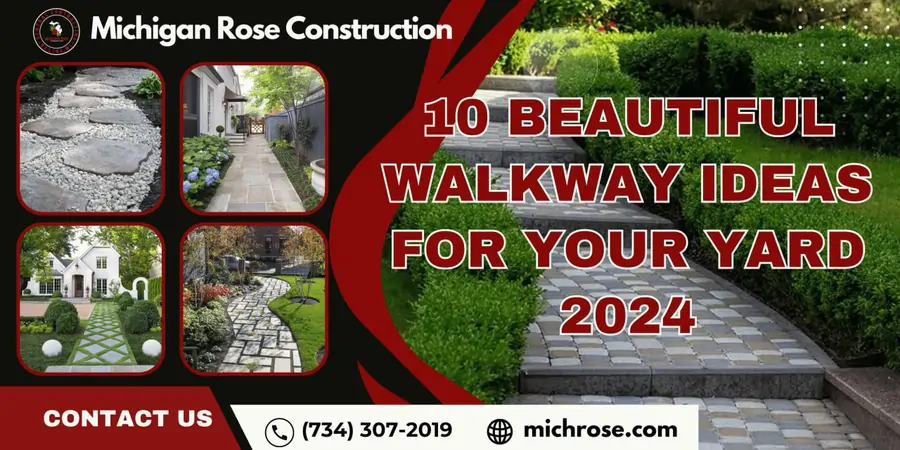
Are you ready to take your yard to the next level? Look no further than a beautiful walkway. Adding a well-designed walkway to your outdoor space is a surefire way to enhance your home’s charm and appeal. With endless options for materials, patterns, and styles, including stunning walkway ideas, you can create a walkway that perfectly complements your unique taste and vision. Not only will a stunning walkway add visual interest to your yard, but it can also provide a welcoming path to your home or garden. This article will showcase ten breathtaking walkway ideas, including innovative walkway designs, to transform your outdoor space into a true oasis. 10 Walkway Ideas That Make Your Yard Look Absolutely Enchanting To help you get inspired, here are ten breathtaking walkway ideas that will transform your outdoor space into a true oasis: 1. Stone Mosaic Walkway A stone mosaic walkway is the perfect addition to elevate the beauty of your outdoor space, especially when considering walkway ideas. Its timeless design can fit any style, and its versatility allows for a custom fit to your preference. This type of walkway can be made with various stones, such as granite, slate, or marble, and cut to your desired size and shape. The possibilities are endless, whether you’re looking for a simple geometric pattern or an intricate design. Plus, a stone mosaic walkway is not only visually stunning but also durable and long-lasting, making it a wise investment for any homeowner who wants to enhance the functionality and aesthetic of their outdoor space. 2. Curved Brick Walkway A curved brick walkway, among other walkway ideas, can add a touch of elegance and charm to any outdoor space. The gentle curve creates a welcoming and inviting path to your home, while the brick material adds a classic and timeless look. Brick walkways can be customized to fit any design preference and laid in various patterns, such as herringbone or basketweave. Additionally, brick walkways are durable and low-maintenance, making them a practical and long-lasting choice for any homeowner. Whether you want to enhance your curb appeal or create a beautiful pathway through your garden, considering a curved brick walkway along with other walkway ideas is a great option. 3. Wooden Boardwalk A wooden boardwalk, among other walkway ideas, is an excellent addition to any outdoor space, particularly those near water. It provides a stable and safe surface for walking, adding a natural and rustic look to the area. Wooden boardwalks can be custom-designed to match the surrounding environment and built to any length or width necessary. They are also low-maintenance and durable, making them a long-lasting investment for any property owner. Whether you want to create a scenic walkway along a river or lake or add a charming pathway through your garden, considering a wooden boardwalk along with other walkway ideas is a great choice. 4. Gravel and Paver Walkway A gravel and paver walkway, among other walkway ideas, is an affordable and attractive way to add a path to your outdoor space. Gravel is a low-maintenance material in various colors and sizes, allowing you to choose the perfect style for your walkway. Pavers can create a border or pattern within the gravel, adding visual interest and stability to the path. This combination provides a natural look that blends seamlessly with any landscape. Additionally, gravel and paver walkways are durable and can withstand heavy foot traffic, making them an ideal choice for high-traffic areas. Whether you want to create a pathway through your garden or connect different areas of your property, considering a gravel and paver walkway along with other walkway ideas is a great choice. 5. Concrete Stepping Stone Walkway A concrete stepping stone walkway, alongside other walkway ideas, provides a durable and low-maintenance option for creating a path in your outdoor space. Concrete stepping stones are available in various shapes, sizes, and colors, making it easy to customize your walkway to match your landscaping. The rocks can be arranged in multiple patterns and designs to create a unique look, and they can be easily replaced if damaged. Additionally, concrete stepping stone walkways are slip-resistant, making them a safe option for areas that may become wet or slick. If you’re looking for a practical and attractive way to connect different areas of your property, considering a concrete stepping-stone walkway along with other walkway ideas is a great choice. 6. Flagstone Walkway Flagstone walkways are a beautiful and natural-looking option for creating a path in your outdoor space. Flagstone is a type of flat stone that comes in various colors and shapes, allowing you to create a unique look for your walkway. They can be arranged in multiple patterns, such as irregular or geometric, to create a visually exciting design. Flagstone walkways are slip-resistant and durable, making them a practical choice for high-traffic areas. A flagstone walkway can add function and style to your outdoor space with proper installation and maintenance. 7. Geometric Paver Walkway A geometric paver walkway is a great way to add a modern touch to your outdoor space. Pavers come in various colors, shapes, and sizes, allowing you to create a unique pattern that can complement the design of your home. Geometric patterns, such as herringbone or basket weave, can add a stylish and contemporary look to your walkway. Pavers are slip-resistant and durable, making them ideal for high-traffic areas. With proper installation and maintenance, a geometric paver walkway can be a long-lasting and practical addition to your outdoor space. 8. Pebble Mosaic Walkway A pebble mosaic walkway can be a beautiful and unique addition to your outdoor space. Pebble mosaics are created by arranging small, smooth stones in a pattern on a bed of sand or concrete. The stones come in various colors and sizes, allowing you to create a design that is visually appealing and personalized to your taste. A pebble mosaic walkway is also slip-resistant and provides a natural feel to your outdoor space. With proper installation and maintenance, a
Concrete Pavers
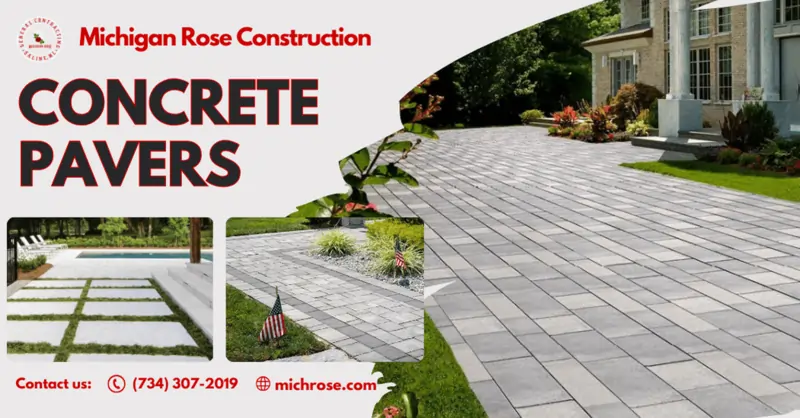
Introduction Concrete pavers, also known as paving stones, are precast blocks typically made of concrete that are laid together to create a durable and attractive surface for driveways, patios, walkways, and more. Though first invented by the Romans and used throughout Europe for centuries, concrete pavers have seen a surge in popularity in Michigan over the past couple decades. With their numerous benefits and customization options, it’s easy to see why concrete pavers have become a top choice for many Michigan homeowners looking to install or replace their exterior living spaces. Pavers provide an affordable yet upscale look, combining the welcoming feel of brick with the strength and longevity of concrete. They also allow for more design flexibility compared to poured concrete or asphalt. As Michigan’s climate brings harsh winters and freeze-thaw cycles, concrete pavers are an ideal solution. Their permeable nature prevents dangerous ice buildup, and it’s easy to replace just one or two damaged pavers rather than redoing an entire slab. With proper installation, concrete pavers can last for decades with minimal maintenance required. Let’s explore why concrete pavers may be the right choice for your next Michigan project. Types of Concrete Pavers Concrete pavers come in a few main types that each have their own unique benefits and uses: Interlocking Concrete Pavers Interlocking concrete pavers, also known as paver stones, are designed to fit together tightly without mortar or gaps. The interlocking design distributes weight and provides strength while still allowing flexibility for the paver surface. Common paver shapes like rectangles, squares, and hexagons can be arranged into various patterns. Interlocking pavers are a great choice for driveways, patios, walkways, and pool decks. Permeable Concrete Pavers Permeable pavers allow water to drain through small spaces between them. They are designed to promote drainage and prevent puddling. Permeable concrete is better for the environment since runoff can flow into the ground instead of the storm drainage system. They work well for driveways, parking areas, and walkways. Paver Sizes, Shapes and Colors Concrete pavers come in a range of sizes, shapes and colors. Standard paver sizes include 4×8 inches, 6×6 inches, 6×9 inches, and 12×12 inches. Common shapes are squares, rectangles, hexagons, and interlocking circles. Colors can be solid hues like red, brown, tan, grey and black. There are also multi-colored blends. The variety allows creativity in laying out patterns and designs. Benefits of Concrete Pavers Concrete pavers offer many advantages for homeowners and businesses in Michigan. Here are some of the top benefits of using concrete pavers: Durability Concrete pavers are an extremely durable paving option for Michigan homeowners. Unlike asphalt, concrete pavers do not crack or fade easily over time. The individual pavers can shift slightly without breaking or crumbling, making them more flexible and resistant to damage. Concrete also withstands extreme temperature fluctuations better than asphalt or poured concrete. Pavers have a typical lifespan of 25-30 years, compared to just 10-15 years for asphalt. And because they are installed in a bed of sand, it’s easy to remove and replace individual damaged pavers if needed. With asphalt, entire sections need to be torn up and repaved if cracking and crumbling occurs. The modular nature of concrete pavers makes spot repairs simple and cost-effective. Overall, concrete pavers are one of the most durable and long-lasting paving options available for Michigan driveways, patios, walkways, and pool decks. Their strength and longevity provide lasting value for homeowners. Aesthetics Concrete pavers come in a variety of shapes, colors, and textures, allowing homeowners to create unique patterns and designs to enhance their home’s curb appeal. Pavers are available in classic squares and rectangles, as well as interesting shapes like hexagons, circles, and interlocking patterns. Mixing and matching different colors and textures can result in eye-catching designs, from simple and elegant to bold and dynamic. The color options are nearly endless, ranging from earth tones like reds, browns, tans, and grays to bright colors like blue, green, yellow, and purple. Textures can be smooth, dimpled, or exposed aggregate, adding visual interest. Pavers can also be stamped with designs during manufacturing for added flair. The flexibility of concrete pavers allows each homeowner to put their personal stamp on their landscape. With the ability to remove and rearrange pavers, homeowners can refresh their home’s look by creating new patterns and designs over time. Concrete pavers are an attractive paving choice that can enhance curb appeal and offer unlimited design flexibility. Easy Installation Concrete pavers are designed for easy installation compared to other paving options. Their interlocking design allows them to be installed quickly without specialized tools or equipment. Homeowners can tackle DIY paver projects if desired. Pavers can also be removed and replaced if one becomes damaged, without having to redo the whole area. Variety of Styles Concrete pavers come in a huge range of colors, shapes, textures and patterns. Popular options include brick, cobblestone, slate, and flagstone designs. Concrete pavers can resemble natural stone at a lower cost. There are endless options for creating a unique look through concrete paver shapes, colors and layout patterns. Permeable Options One of the key benefits of concrete pavers is their permeability. Unlike poured concrete or asphalt, concrete pavers have small spaces between each paver that allow water to drain through. This gap drainage system helps prevent flooding, stormwater runoff, and drainage issues. Concrete pavers effectively manage water flow and allow excess water to drain away from paved surfaces. The water drains through the joints between pavers and into an open-graded crushed stone base underneath. This base acts as a reservoir to temporarily store water and allow it to infiltrate the native soil below. This permeability makes concrete pavers an environmentally friendly paving solution. They reduce problems with standing water, prevent pollutants from accumulating on paved surfaces, and minimize runoff into storm drains. Their ability to replenish groundwater supplies through infiltration is a major sustainability benefit as well. Overall, the permeability of concrete pavers is a key advantage that makes them an ideal paving material for
Best Small Patio Ideas
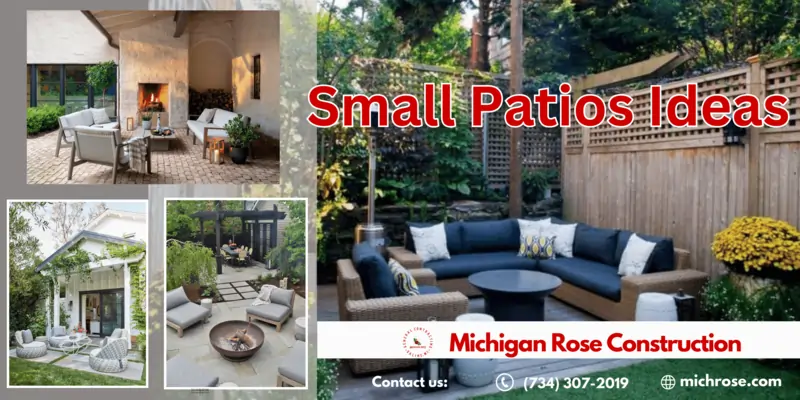
Small Patio Ideas: Introduction Small patio ideas are becoming increasingly popular for homes in Michigan. The state’s temperate climate allows residents to enjoy outdoor spaces for much of the year. Small patio provide a cozy outdoor living area without taking up too much yard space. Small patio offer many benefits compared to larger patios. They allow homeowners to create an intimate gathering area for family and friends. The smaller scale also makes them more affordable. Less materials are needed for the patio surface, landscaping, and furnishings. Small patio are easier to decorate and maintain as well. This article will provide ideas and inspiration for designing a small patio in Michigan. We’ll cover popular patio styles, materials, creative layouts, space-saving furniture, low maintenance plants, and more. Tips for adding privacy, protection from weather, and pet-friendly features will also be included. By the end, you’ll have plenty of options for creating a charming small patio oasis. Popular Small Patio Styles Small patio ideas in Canton Michigan can showcase different design styles to match home architecture and personal taste. Here are some of the most popular styles for small patios: Modern The modern patio emphasizes clean lines, geometric shapes, and minimal ornamentation. This contemporary look features sleek outdoor furniture with neutral colors like gray, white, or black. Add pops of color with bright accent pillows, rugs, or potted plants. Modern materials include concrete, stone, metal, glass, and wood. Rustic Rustic small patio have a cozy, natural vibe with an emphasis on wood and stone. Incorporate salvaged wood, galvanized metal, and wicker for furniture. Weathered wood planter boxes and stone fire pits add to the earthy look. Vines, herbs, and flowering plants enhance the organic style. Mediterranean Inspired by Southern Europe, the Mediterranean patio combines elegant arches, tile, wrought iron, and potted citrus trees. White or neutral walls contrast nicely with terracotta tile flooring. Decorate with brightly colored cushions and ceramics. The Mediterranean look includes an outdoor kitchen, fountain, vines, and herbs. Contemporary The contemporary patio has a sleek, refined style using a simple color palette, clean lines, and minimal clutter. Think modern materials like glass, steel, and concrete combined in an unfussy way. Contemporary patios may include an outdoor fireplace, built-in seating, and low-maintenance greenery. Small Patio Ideas: Best Materials When designing a small patio, choosing the right materials is key to creating an inviting and functional outdoor space. Some of the most popular and durable options for small patios in Michigan include: Concrete Concrete is one of the most common patio materials. It’s affordable, easy to install, and very durable. Concrete patios can last for decades with proper installation and maintenance. Concrete offers some advantages for small patios: Be sure to have concrete installed by a professional and sealed to prevent staining and damage over time. Consider adding a broom finish for traction. You may also want to read: Stamped Concrete Stone Natural stone like slate, bluestone, or flagstone creates a classic, elegant patio. Stone comes in a range of earthy colors that complement gardens and landscaping. For small patios, opt for stone pavers or irregular flagstone patterns, which have a more intimate scale. This material works well for patios with tight corners or unusual shapes. Pros of natural stone: Stone is more expensive upfront but worth the investment for its enduring good looks. Be sure the base is well-prepared to prevent shifting. Brick Brick is another classic choice that offers timeless appeal, especially for traditional home styles. Clay brick comes in various shapes, colors, textures, and patterns. For small spaces, choose smaller brick pavers rather than large blocks, which can overwhelm the area. Mix colors for a charming cottage look or do a simple grid pattern in one hue. Key benefits of brick patios: Properly installed and sealed brick patios will last for decades of gatherings and memories. Wood Wood offers a warm, natural look for small patios in Michigan. It’s softer underfoot than stone or concrete. Popular wood choices include cedar, redwood, and pressure-treated pine. Considerations for wood patios: Wood is best for covered patios or cooler, shaded spots. Use naturally rot-resistant woods like cedar or redwood, and properly space deck boards to allow drainage. Treat wood with weather-resistant sealants. Overall, opt for the patio material that best fits your budget, design style, and maintenance capabilities. Any of these options can create an inviting small patio oasis! Creative Small Patio Ideas Small patio can feel cramped and uninspired. With some creative touches, you can transform your patio into an inviting oasis, even with limited space. Here are some creative ideas to make the most of your small patio in Michigan: Container Gardens Container gardens are a great way to add pops of color, fragrance, and texture to a small patio. Arrange a collection of pots and planters in varying shapes, sizes, and materials. Go for a cohesive look by using complementary colors. Or create an eclectic look with a mix of plants and containers. Be sure to include pots with trailing vines and cascading greenery to soften edges and add vertical interest. Fire Pits A fire pit extends the enjoyment of a patio into the evening hours. Portable fire pits are ideal for small patios – just roll it out when wanted. Choose a style with a mesh screen to prevent flying embers. Position it near the house for safety. Pull up some chairs and enjoy the flickering ambience. Outdoor Lighting Strategically placed lighting can make a small patio feel warm and inviting after dark. Go for pathway lighting to define the space. Up-lights placed in trees or against walls create ambience. String lights add whimsy overhead or wrapped around railings. Opt for solar lights to avoid wiring. Water Features The pleasant sounds of moving water can make a small patio feel tranquil and serene. A tabletop fountain adds lovely ambience without taking up floor space. Or install a compact wall-mounted fountain. For a narrow space, try a linear fountain designed specifically for tight spots. Outdoor water features require
10 Benefits of Using Pavers in Your Outdoor Living Space
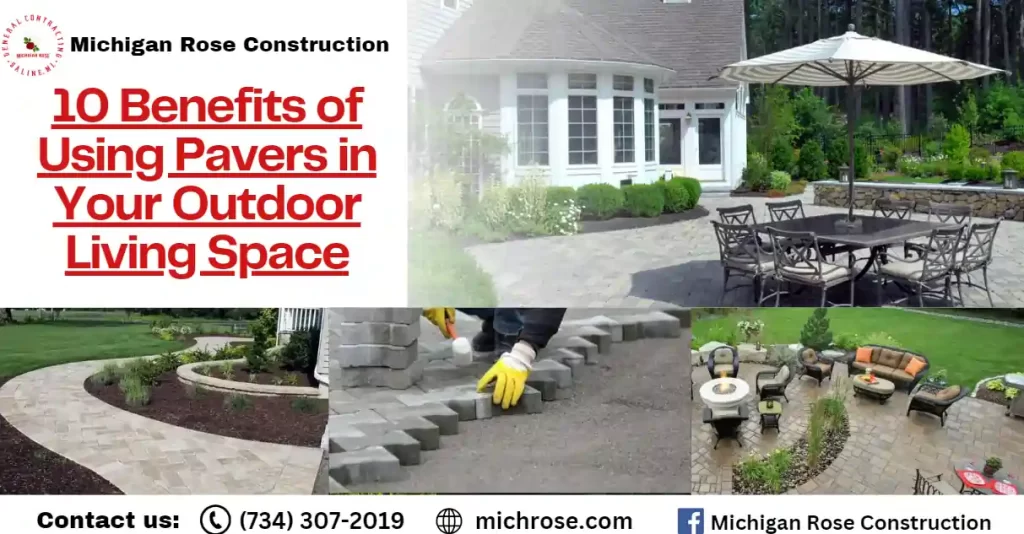
Do you want to design a long-lasting, aesthetically pleasing, and practical outdoor living area? As a Michigan homeowner, designing and maintaining an outdoor living space can be a challenging task. However, incorporating the benefits of using pavers as a ground cover can offer a range of benefits to enhance your outdoor space’s aesthetics, functionality, and durability. Pavers are versatile, durable, and low-maintenance materials that can transform a bland outdoor space into a beautiful and functional extension of your home. This article will explore the top 10 benefits of using pavers in your outdoor living space, including their affordability, durability, versatility, and adaptability to different design styles. Whether you want to create a cozy seating area, a stunning garden path, or a spacious patio, pavers can help you achieve your desired look while enjoying their many benefits. Top 10 Benefits of Using Pavers 1. Versatility One of the significant benefits of using pavers is their versatility. Pavers come in various colors, patterns, and shapes, allowing for substantial customization. They can be used for multiple applications, including walkways, patios, driveways, and pool decks. Pavers are also durable and low-maintenance, making them popular for homeowners and businesses. Additionally, they are environmentally friendly and can be easily recycled, making them a sustainable option for outdoor construction projects. 2. Durability Pavers are known for their durability, making them an excellent choice for outdoor construction projects. The benefits of using pavers include their ability to withstand heavy foot traffic, extreme weather conditions, and even vehicle traffic, unlike other materials such as concrete or asphalt. This durability means they are a low-maintenance option, requiring minimal repairs or replacements. Overall, pavers offer the benefits of using pavers as a reliable and long-lasting investment for any outdoor space. 3. Low-maintenance One of the benefits of using pavers is their low-maintenance nature. Once installed, pavers require minimal upkeep compared to other outdoor construction materials. They are highly durable and can withstand heavy foot traffic, extreme weather conditions, and vehicle traffic. Pavers also resist cracking and erosion so they won’t need frequent repairs or replacements. Overall, pavers are an excellent choice for outdoor spaces that require a reliable and long-lasting solution. 4. Slip-resistant Slip resistance is another great benefit of using pavers. Pavers come in various textures and finishes that offer excellent traction, making them ideal for pool decks, walkways, and other outdoor areas where slipping hazards are a concern. The slip-resistant quality of pavers also makes them a popular choice for commercial spaces, such as shopping centers and restaurants, where safety is a top priority. 5. Easy to repair One of the many benefits of using pavers is that they are easy to repair. If a paver gets damaged or stained, it can be removed and replaced with a new one without disturbing the surrounding pavers. This makes pavers a cost-effective and practical option for outdoor flooring as it eliminates the need to replace the entire surface in case of damage. Additionally, repairing pavers is a simple DIY task that can be done without professional assistance, saving you both time and money. 6. Eco-friendly Pavers are an environmentally sustainable choice for outdoor flooring, which is just one of its many benefits. The benefits of using pavers include their composition of naturally occurring materials like clay, concrete, or natural stone, making them sustainable for the environment. Additionally, pavers are permeable, which lowers the risk of erosion and floods by allowing precipitation to absorb into the ground rather than flowing off into storm drains. Incorporating the benefits of using pavers for outdoor flooring is an excellent method to help create a more sustainable and greener environment. 7. Enhance curb appeal Another benefit of using pavers is that they can enhance the curb appeal of your property. Pavers are available in various colors, shapes, and patterns, giving you the flexibility to create a unique look for your outdoor space. Whether you want a classic, traditional style or a modern, contemporary design, pavers can help you achieve the desired look. Plus, the durability and longevity of pavers can improve the overall value of your property, making it a worthwhile investment. 8. Cost-effective Pavers are not only aesthetically pleasing, but they also offer the benefits of using pavers as a cost-effective option for outdoor flooring. Pavers are relatively cheaper to install and maintain than other materials like concrete or asphalt. Additionally, if a paver gets damaged or stained, you can easily replace it without redoing the entire surface. This makes pavers a practical and budget-friendly choice for enhancing your outdoor space. 9. Adaptability Pavers are a highly adaptable option for outdoor flooring, offering the benefits of using pavers to enhance versatility. They come in various shapes, sizes, colors, and textures, giving you the flexibility to create a unique design that perfectly matches your style and preferences. Depending on your taste, pavers can be used to create intricate patterns or simple designs. Moreover, they can be easily combined with other materials like gravel or grass to create a more natural look. This adaptability makes pavers a popular choice among homeowners and landscapers alike. 10. Quick installation One of the benefits of using pavers for outdoor flooring is that they can be quickly installed. Unlike other types of outdoor flooring, such as concrete or natural stone, pavers can be laid down in a matter of days, depending on the size of the area to be covered. This makes them an excellent option for homeowners who want a quick and hassle-free solution for their outdoor flooring needs. Additionally, because pavers are pre-cut and ready to install, there is no need to wait for them to dry or cure, further speeding up the installation process. Reference for Best Pavers Manufacturers Does A Paver Patio, Extensions and Walkways Add Home Value? Are you looking for a way to add value to your home while enhancing its overall appearance? Consider the benefits of using pavers for walkways, patios, and extensions. Pavers are a solid, long-lasting option for high-traffic areas, offering
Enhancing Your Patio with Stamped Concrete

Introduction Your patio should be an extension of your living space – a welcoming place to relax, entertain, and make lasting memories. The sweet aroma of blooming flowers in the air, the glow of string lights overhead, and the peaceful ambiance of your personal outdoor oasis. A patio has the power to transform your backyard into a sanctuary and gathering place. However, creating this idyllic space involves more than just patio furniture and plants. The patio surface itself plays a critical role in the aesthetics, functionality and enjoyment of the space. Stamped concrete has emerged as a versatile, innovative solution for crafting beautiful, distinctive patios. This building material can be molded and patterned to mimic natural materials like stone, wood, brick and tile. With limitless customization options, stamped concrete allows you to design a patio surface that reflects your personal style. It’s durable enough to handle the elements while providing an eye-catching focal point to your outdoor living area. In this guide, we’ll explore the world of stamped concrete – uncovering its unique benefits, design capabilities, installation process and more. By the end, you’ll see why stamped concrete deserves a spot at the top of your patio surface list, as an artistic yet practical material that can transform your space into a welcoming backyard oasis. What is Stamped Concrete? Stamped concrete is a versatile building material created by imprinting patterns onto freshly poured concrete to make it resemble natural materials like stone, brick, slate, and wood. Unlike conventional concrete that is smooth and gray, stamped concrete uses textured mats, stamps, or rollers to imprint designs and textures into the concrete surface before it fully cures. The stamping process not only creates an attractive, realistic finish but also enhances the durability and strength of the concrete. Stamped concrete is most commonly used for outdoor living spaces like pool decks, patios, walkways, and driveways. It provides a low-maintenance and cost-effective alternative to genuine stone, brick, and pavers. The unique process of stamped concrete involves: The result is a highly customizable concrete surface that resembles natural building materials, with the durability to withstand outdoor conditions. Stamped concrete brings beauty, sophistication, and creativity to any landscape or hardscape design. Benefits of Using Stamped Concrete for Patios Stamped concrete offers numerous advantages that make it a top choice for patios: Durability Unlike natural stone, stamped concrete is less prone to cracking and chipping over time. The concrete mixture can be designed to withstand heavy foot traffic, furniture dragging, harsh weather conditions, and more. It won’t rot or splinter like wood decking either. Its unrivaled durability ensures your patio will look pristine for decades to come with minimal repairs needed. Low Maintenance Keeping your patio looking sharp doesn’t require intensive upkeep with stamped concrete. Just occasional pressure washing and resealing every 2-3 years will maintain its beauty. No need for constant sweeping, power washing, staining, waterproofing, or other maintenance like natural stone or wood require. The minimal maintenance needs make stamped concrete a great option for busy homeowners. Design Versatility From mimicking flagstone, slate, cobblestone, brick and other textures to incorporating colors and patterns – stamped concrete offers endless design possibilities. It can complement any style from Mediterranean to modern. Borders, bands, emblems, and more can be seamlessly integrated too. Stamped concrete provides a versatile canvas to create a patio that reflects your personality and design aesthetic. Mimicking Natural Materials Stamped concrete is valued for its ability to replicate the look and texture of natural building materials like stone, brick, and wood. When stamped, concrete can take on the appearance of a vast range of materials while retaining the strength and durability concrete is known for. The stamping process imprints realistic patterns into the concrete to mimic materials like: The ability to mimic these prized building materials is what makes stamped concrete such a versatile design option for patios. It provides the natural visual appeal homeowners want without the upkeep issues of real stone, brick, slate or wood. Concrete stamps by Brickform Concrete stamps from Brickform can be repeatedly used to provide residential or commercial concrete a textured finish. Select from a range of grout lines, sizes, joints, and layouts. For your reference: Concrete Stamps Customization Options One of the most appealing aspects of stamped concrete is the immense range of customization options it provides for your patio. With stamped concrete, you can choose from a diverse palette of colors, textures, and patterns to create a look that aligns with your vision. Colors Stamped concrete offers a full spectrum of color choices to match any style. Earthy tones like beige, brown, and terra cotta evoke a natural vibe, while grays add an urban modern touch. Bold colors like reds or blues make a dramatic statement. You can even opt for a mottled effect by blending multiple colors together. This allows you to match existing color schemes or create unique combinations. Textures Textures add visual interest and dimension to your patio. Stamped concrete can mimic materials like stone, brick, slate, and tile. Rustic wood plank textures offer warmth and charm. Granite, limestone, and travertine patterns provide elegance. Abstract and geometric textures lend a contemporary flair. With countless options, you can find the perfect texture to complement your landscape. Patterns Stamped concrete isn’t limited to a single texture—you can imprint patterns by layering complementary textures and colors. Blend stone and brick textures in contrasting hues for rustic ambiance. Combine slate and tile patterns in muted tones for an elegant courtyard feel. Mix geometric shapes in bold colors for an artful look. The pattern possibilities are endless with stamped concrete. With its unparalleled range of customization options, stamped concrete enables you to design a patio that brings your unique vision to life. Tailor colors, textures and patterns to create an outdoor oasis reflecting your style. Design Considerations When designing your stamped concrete patio, there are several factors to consider that will impact its functionality and aesthetic. Climate The climate of your region is a key consideration, as it
8 Best Deck Materials for Building a Deck that Last
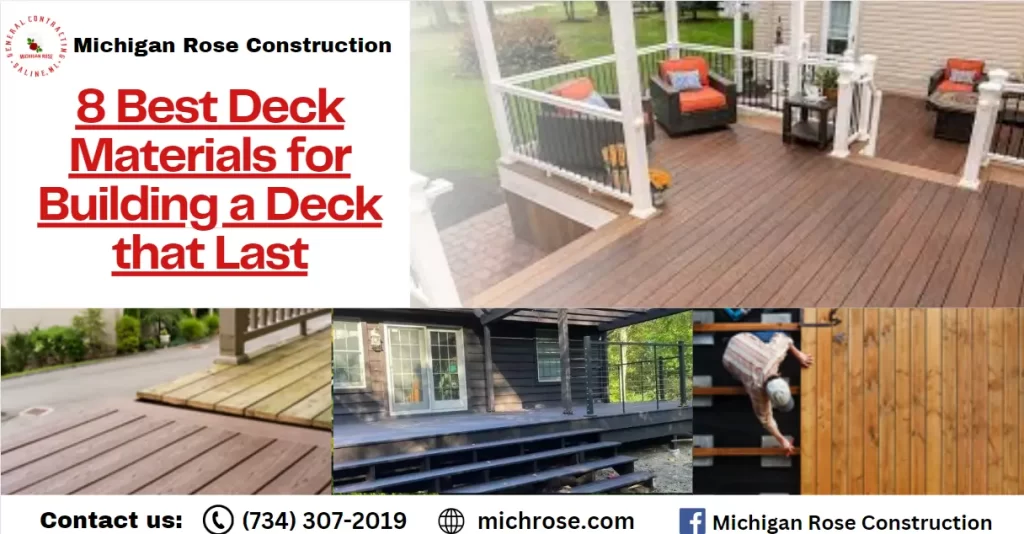
Discover the 8 best deck materials for building a long-lasting deck and compare TimberTech vs Trex composite decking to find the perfect option for your space.
Concrete Driveway Replacement
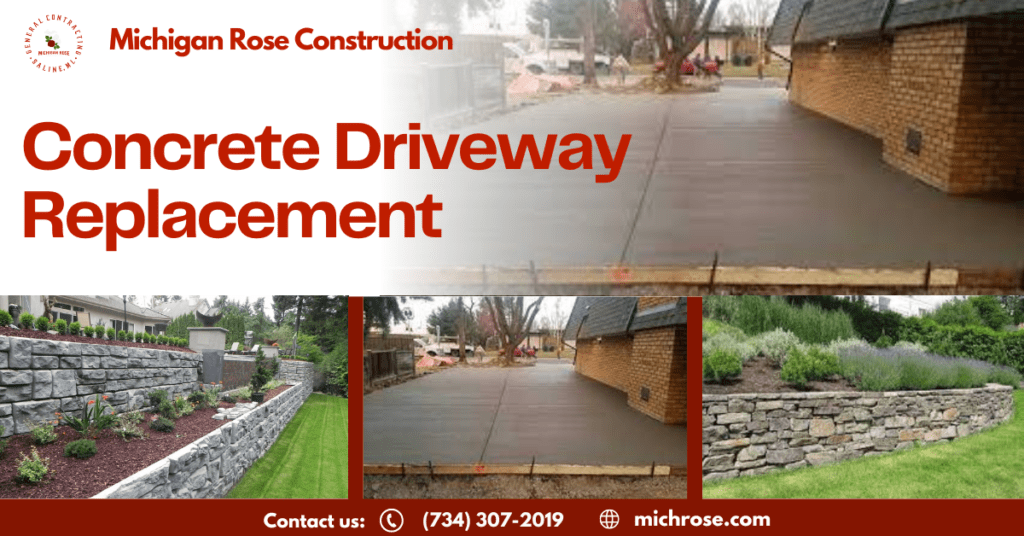
Introduction Concrete Driveway Replacement Near Me: Curb appeal is one of the most important factors when it comes to home value. The driveway is often the first part of a home that people notice and a worn, cracked concrete driveway can immediately turn off potential home buyers. Replacing an old, damaged concrete driveway is one of the best investments you can make to increase your home’s curb appeal. A new, smooth concrete driveway makes a great first impression and lets buyers know that the home is well-maintained. It shows you care about the details and aesthetics of your property. In addition, it improves functionality by eliminating cracks and uneven surfaces. Replacing a driveway also provides an opportunity to upgrade the look with new concrete finishes and designs. This article will overview the benefits of concrete driveway replacement near me and what’s involved in the process. We’ll look at options for concrete finishes, ways to improve drainage, design considerations, and maintenance tips. By the end, you’ll understand why investing in a new concrete driveway can pay off when it comes to boosting your home’s curb appeal and value. Why Replace an Old Concrete Driveway? Concrete driveways develop issues over time that make replacement worth considering. As the driveway ages, it’s common to see cracks, damage, and uneven settling that impacts functionality and aesthetics. Cracks are one of the most obvious signs that a concrete driveway is failing. Temperature changes, ground movement, improper installation, and wear can cause cracks to form and widen over the years. Left unaddressed, cracks allow water to seep under the concrete and cause further deterioration. They also present tripping hazards and collect dirt and debris. Settling and unevenness in an aging concrete driveway can create bumpy, uneven, or sloped surfaces. This makes using the driveway repair difficult, with impaired traction and drainage issues. Low spots collect water, while high points put excess strain on vehicles. Severe settling requires frequent repaving or mudjacking to temporarily even out the surface. Replacing an old, damaged concrete driveway dramatically improves aesthetics with a smooth, properly sloped, and even surface. Eliminating large cracks and trip hazards also enhances safety and functionality. The visual appeal of a pristine concrete driveway repair also boosts curb appeal. Benefits of Replacing Your Concrete Driveway Replacing an old, cracked concrete driveway can provide numerous benefits that make it a worthwhile home improvement project. Here are some of the top reasons to consider concrete driveway replacement: Improved Curb Appeal One of the biggest benefits of replacing a driveway is enhancing your home’s curb appeal. An old, stained, and cracked driveway makes a poor first impression on visitors and potential home buyers. Replacing it with a new, pristine concrete driveway immediately boosts your home’s aesthetic. The clean, smooth look of fresh concrete is attractive and inviting. It makes your home look well-maintained and more valuable. Curb appeal goes a long way toward attracting buyers if you decide to sell. Increased Home Value Investing in a new driveway brings a excellent return on investment. Not only does it increase curb appeal, it also directly adds value to your home. The cost of the concrete driveway replacement project can be recouped when selling your home. According to Remodeling Magazine, replacing an asphalt driveway with concrete has a 70.3% ROI, while a paver driveway has a 75% ROI. This makes driveway replacement one of the most worthwhile investments. Safer Surface Old driveways develop cracks, pitting, crumbling sections and uneven surfaces over time. This makes them unsafe by creating trip hazards. The smooth, even surface of a new concrete driveway eliminates these risks. New concrete is also less slippery than old concrete that has become polished and worn over many years of use. The increased safety is especially important for homes with elderly residents. Easier to Maintain A new driveway is practically maintenance-free compared to an old one riddled with problems. Resealing, patching cracks, repairing crumbling sections, and cleaning stained areas takes time, effort and money. A new concrete driveway should last decades before major repairs are needed, depending on climate, usage and concrete quality. The minimal maintenance of a new driveway is light years easier compared to constantly maintaining an old one. Read more about Asphalt and Concrete Driveway.. Process of Concrete Driveway Replacement Concrete driveway replacement in Michigan is a significant project that requires proper planning and execution. Here are the key steps involved: Demolition and Removal of Old Driveway The first step is to demolish and remove the existing concrete driveway. This typically involves using a jackhammer and other tools to break up the concrete into manageable sections. The broken up pieces of concrete are then loaded into a dump truck and hauled away. Any underlying aggregate base material will also be removed. It’s important to take safety precautions during demolition, such as wearing eye protection and gloves. Care should also be taken not to damage any underground utilities, irrigation lines or surrounding structures. Hiring professionals for demolition is often the easiest and safest route. Grading and Preparation of Base Once the old driveway is removed, the ground needs to be graded and prepared for the new driveway base. This involves leveling the soil, removing any high or low spots, and compacting the ground. Proper grading is crucial to ensure adequate drainage under and around the new concrete. Some drainage systems, like french drains or catch basins, may need to be installed before the new driveway is poured. After grading, a gravel base will be added and compacted. This provides a stable foundation on which to pour the new concrete driveway. The depth of the base layer depends on the climate and soil type. Pouring and Finishing New Concrete The next step is pouring the new concrete for the driveway. Forms will be erected along the edges to hold the liquid concrete in place while it cures. Concrete should be poured continuously to prevent cold joints from forming. As soon as possible after pouring, the concrete will be finished
The Benefits of Installing an Outdoor Fire Pit This Summer
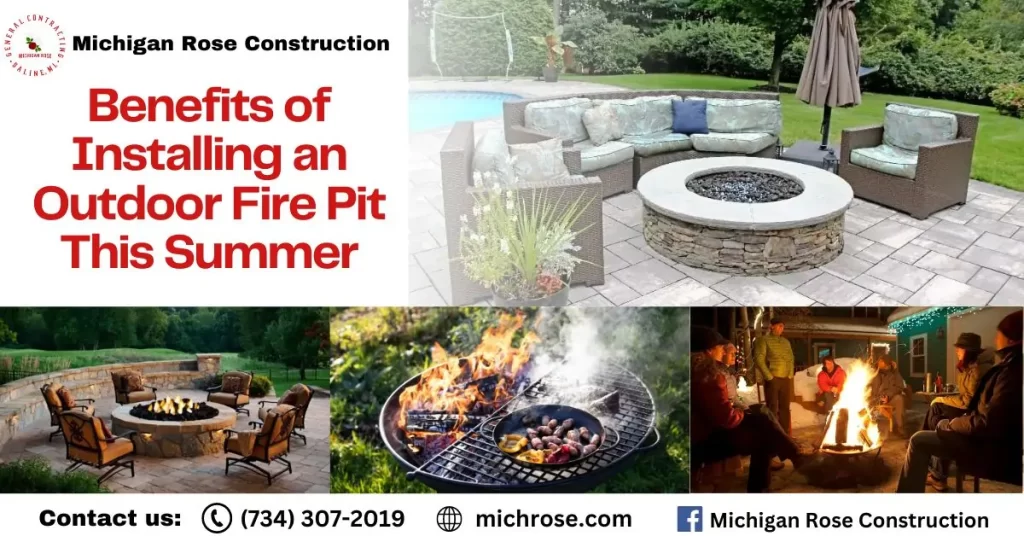
Relax in the Summer with a Customized Outdoor Fire Pit Summertime is an excellent time for locals in Ann Arbor, Belleville, Birmingham, Brighton, and Canton Michigan, to enjoy the outdoors with loved ones. Installing an outdoor fire pit in your backyard can transform your outdoor space and enhance your home. As summer approaches, a outdoor fire pit provides a cozy gathering place to enjoy the warm evenings outside. This article will explore the key benefits of adding a outdoor fire pit to make the most of the summer season. We’ll cover how a outdoor fire pit boosts ambiance, facilitates outdoor living and entertaining, enables cooking, provides warmth, promotes relaxation and family bonding, and can increase property value. By the end, you’ll clearly understand how a fire pit can upgrade your backyard and enrich your summer experiences. Benefits of Installing an Outdoor Fire Pit Introduction Installing an outdoor fire pit in your backyard can transform your outdoor space and enhance your home. As summer approaches, a outdoor fire pit provides a cozy gathering place to enjoy the warm evenings outside. This article will explore the key benefits of adding a outdoor fire pit to make the most of the summer season. We’ll cover how a fire pit boosts ambiance, facilitates outdoor living and entertaining, enables cooking, provides warmth, promotes relaxation and family bonding, and can increase property value. By the end, you’ll clearly understand how an outdoor fire pit can upgrade your backyard and enrich your summer experiences. Ambiance and Aesthetics Adding an outdoor fire pit to your backyard or patio can significantly enhance the ambiance and aesthetics of the space. A fire’s flickering glow and warmth create an inviting atmosphere that encourages people to gather around, making it an ideal focal point for an outdoor living area. A outdoor fire pit made from natural stone or brick has an organic, earthy look that blends well with landscaping. The structure and flames add visual interest to what might otherwise be an empty, dull space. Thoughtful placement and design of an outdoor fire pit can turn a bare backyard into a gorgeous oasis for relaxing. Outdoor Fire pits come in many shapes, sizes, and materials. A custom-designed outdoor fire pit that complements the architecture and style of your home can look stunning. Even a simple pre-fabricated metal model adds flair. The mesmerizing movement of the flames and the ever-changing light display transform the yard into a more beautiful and captivating setting. When lit at night, an outdoor fire pit creates a warm, welcoming glow that lights up the patio, yard, or pool area. The flames provide a lovely ambiance that encourages people to unwind and enjoy the space long after sunset. A outdoor fire pit extends opportunities for outdoor living into the evening hours. It allows you to fully leverage your outdoor real estate for beauty and enjoyment. Outdoor Living A outdoor fire pit extends the enjoyment of the outdoors into cooler evenings and seasons. Sitting around a cozy outdoor fire pit allows you to use your yard, patio, or deck long after summer. The flickering glow creates a unique ambiance that encourages conversation and quality time. As the seasons change and daylight hours grow shorter, having a outdoor fire pit provides a designated gathering place to soak in the fresh air. Evenings around the outdoor fire pit allow you to dine al fresco, do backyard stargazing, or relax outside. It transforms your outdoor space into a three-season or four-season living area. With a outdoor fire pit, you can comfortably host guests outside when the temperatures dip. Friends will enjoy mingling around the warmth and lighting. Unlike indoor rooms where guests can spread out, anoutdoor fire pit is a focal point that brings people together. The fire encourages interaction and storytelling. Having a outdoor fire pit extends your enjoyment of long summer nights outdoors. You can stay outside well into the evening for special celebrations, parties, or quiet nights at home. The mood of an outdoor fire is unbeatable. It feels like you’re camping in the comfort of your yard. An outdoor fire pit will be used more than you may expect. Entertaining A outdoor fire pit provides an excellent gathering place for entertaining guests outdoors. The flickering glow of the flames creates an inviting ambiance that encourages conversation and connection. Guests will be drawn outside around the fire, making it easy to host casual get-togethers or even formal dinner parties al fresco. Cooking over an open fire is always a crowd-pleaser. Roasting marshmallows for s’mores is a classic camping tradition that translates seamlessly to outdoor fire pit entertaining. Grilling kebabs, hot dogs, or other foods over the fire adds a delicious smoky flavor. For larger groups, consider cooking up a batch of chili, soup, or other campfire stew to feed the whole crowd. The outdoor fire pit gives people a place to congregate, mingle, and enjoy each other’s company for hours. As the sun goes down and the air becomes cooler, the warmth from the fire allows you to comfortably extend the party into the evening. The fire becomes the focal point, keeping people engaged long after dinner is done and the wine is gone. Entertaining around the fire pit is always a memorable experience for you and your guests. Cooking A outdoor fire pit allows you to cook foods outdoors that you can’t easily make inside. The open flame is perfect for roasting hot dogs, toasting marshmallows for s’mores, cooking kebabs, potatoes wrapped in foil, corn on the cob, and other campfire classics. Kids will love gathering around the fire to roast marshmallows into gooey perfection before sandwiching them with chocolate between graham crackers. Even cooking simple things like hot dogs over an open fire adds a unique flavor. An outdoor fire pit allows you to enjoy summer classics like s’mores or experience cooking new stuff over the fire. It also provides a great reason to spend time outside around the warmth of the flames while preparing tasty treats. Cooking
































